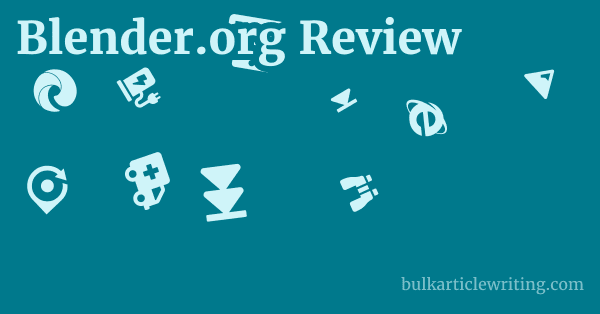Blender.org comprehensively details the robust feature set of its namesake software, Blender.
Read more about blender.org:
Blender.org Review & First Look
Is Blender.org Legit? Unpacking Its Credibility
From its advanced rendering capabilities to intricate animation tools, the website paints a clear picture of a versatile and powerful 3D creation suite. It’s not just a collection of tools.
it’s a fully integrated pipeline designed to handle complex projects across various domains.
Cycles Render Engine
The website highlights Cycles Render Engine as Blender’s “built-in powerful unbiased path-tracer engine that offers stunning ultra-realistic rendering.” This is the engine that brings 3D scenes to life with incredible fidelity. Key features mentioned include:
|
0.0 out of 5 stars (based on 0 reviews)
There are no reviews yet. Be the first one to write one. |
Amazon.com:
Check Amazon for Blender.org Features: A Latest Discussions & Reviews: |
- Real-time viewport preview: This allows artists to see their changes rendered in real-time, significantly speeding up the iterative process.
- CPU & GPU rendering: Users have the flexibility to utilize either their central processing unit or graphics processing unit for rendering, depending on hardware and performance needs. This offers significant optimization.
- PBR shaders & HDR lighting support: Support for Physically Based Rendering (PBR) and High Dynamic Range (HDR) lighting ensures that materials and lighting behave realistically, crucial for professional-grade visuals.
- VR rendering support: This is a forward-thinking feature, catering to the growing demand for virtual reality content creation. The ability to render for VR directly within Blender is a major advantage.
This comprehensive rendering solution ensures that anything designed in Blender can achieve a visually stunning output.
Modeling, Sculpt, UV
Blender’s strength in polygonal and digital sculpting is prominently featured.
The website emphasizes “Blender’s comprehensive array of modeling tools make creating, transforming and editing your models a breeze.” Specific tools and capabilities include:
- Full N-Gon support: This is a crucial feature for clean topology and efficient modeling, allowing for complex shapes to be created with fewer polygons.
- Edge slide, inset, grid and bridge fill, and more: These are fundamental modeling operations that streamline the process of building detailed and complex meshes.
- Advanced sculpting tools and brushes: Blender’s sculpting capabilities rival dedicated sculpting software, allowing for organic and highly detailed model creation.
- Multi-resolution and Dynamic subdivision: These enable artists to work on low-polygon models for performance while maintaining high-resolution detail.
- 3D painting with textured brushes and masking: This allows for direct texture application onto 3D models, making the texturing process intuitive and integrated.
- Python scripting for custom tools and add-ons: The extensibility through Python means users can tailor the software to their specific workflows or even develop and share their own tools, significantly enhancing productivity.
VFX (Visual Effects)
For visual effects professionals, Blender offers a compelling integrated solution. Is 1smtg.com a Scam?
The website quotes VFX professionals saying: “Probably the best tracker in the market.” This is a bold claim, but it underscores Blender’s robust capabilities in this area.
- Production ready camera and object tracking: This allows users to seamlessly integrate 3D elements into live-action footage by accurately tracking camera movements and objects.
- Import raw footage, track, mask, and see live in 3D scene: The ability to perform the entire VFX workflow—from footage import to final integration—within a single application is a significant time-saver, “Eliminating the need to switch between programs.”
- Auto and Manual tracking: Provides flexibility for different tracking scenarios, from automated solutions to precise manual adjustments.
- Powerful camera reconstruction: Ensures accurate recreation of real-world camera parameters for perfect integration.
- Real-time preview of your tracked footage and 3D scene: This immediate feedback loop is invaluable for artists to visualize and refine their composites.
- Support for Planar tracking and Tripod solvers: Offers advanced tracking methods for various challenging scenarios, making Blender a versatile tool for professional VFX work.
Animation & Rigging
Blender’s animation pipeline is extensively highlighted, noting its use in “numerous short films, advertisements, TV series and feature films now.” This demonstrates its professional viability. Key animation and rigging features include:
- Envelope, skeleton and automatic skinning: Essential tools for preparing 3D characters for animation, allowing for flexible and natural deformation.
- B-spline interpolated bones: Provides smoother and more controllable bone deformations, leading to more fluid animations.
- Curve editor and dope sheets: Industry-standard tools for precise control over animation timing, easing, and keyframes.
- Custom bone shapes for fast input: Allows animators to create intuitive control rigs, making the animation process more efficient.
- Sound synchronization: Critical for animated content, enabling precise timing of actions to audio cues.
These features make Blender a formidable tool for character animation, motion graphics, and even large-scale animated productions.
Story Art, Drawing 2D in 3D
This is a unique and innovative feature that distinguishes Blender.
The website states, “Really! Drawing directly in a 3D viewport makes a lot of sense. Is Blender.org Legit? Unpacking Its Credibility
It opens unsurpassed workflow freedom for story-boarders and 2D artists.”
- Combine 2D with 3D right in the viewport: This allows artists to draw and sketch in a 3D environment, creating unique hybrid workflows for concept art, storyboarding, and animatics.
- Full Animation Support with Onion Skinning: Critical for 2D animation, onion skinning allows artists to see previous and next frames, facilitating fluid movement.
- Layers & Colors for Stroke and Fill: Provides granular control over 2D elements within the 3D space, similar to traditional 2D animation software.
- Sculpt brush strokes & Parent to 3D objects: Allows for dynamic manipulation of 2D lines and their integration with 3D models, opening up new creative possibilities.
This feature significantly expands Blender’s utility, making it appealing to artists who bridge the gap between traditional 2D and modern 3D workflows.

Leave a Reply